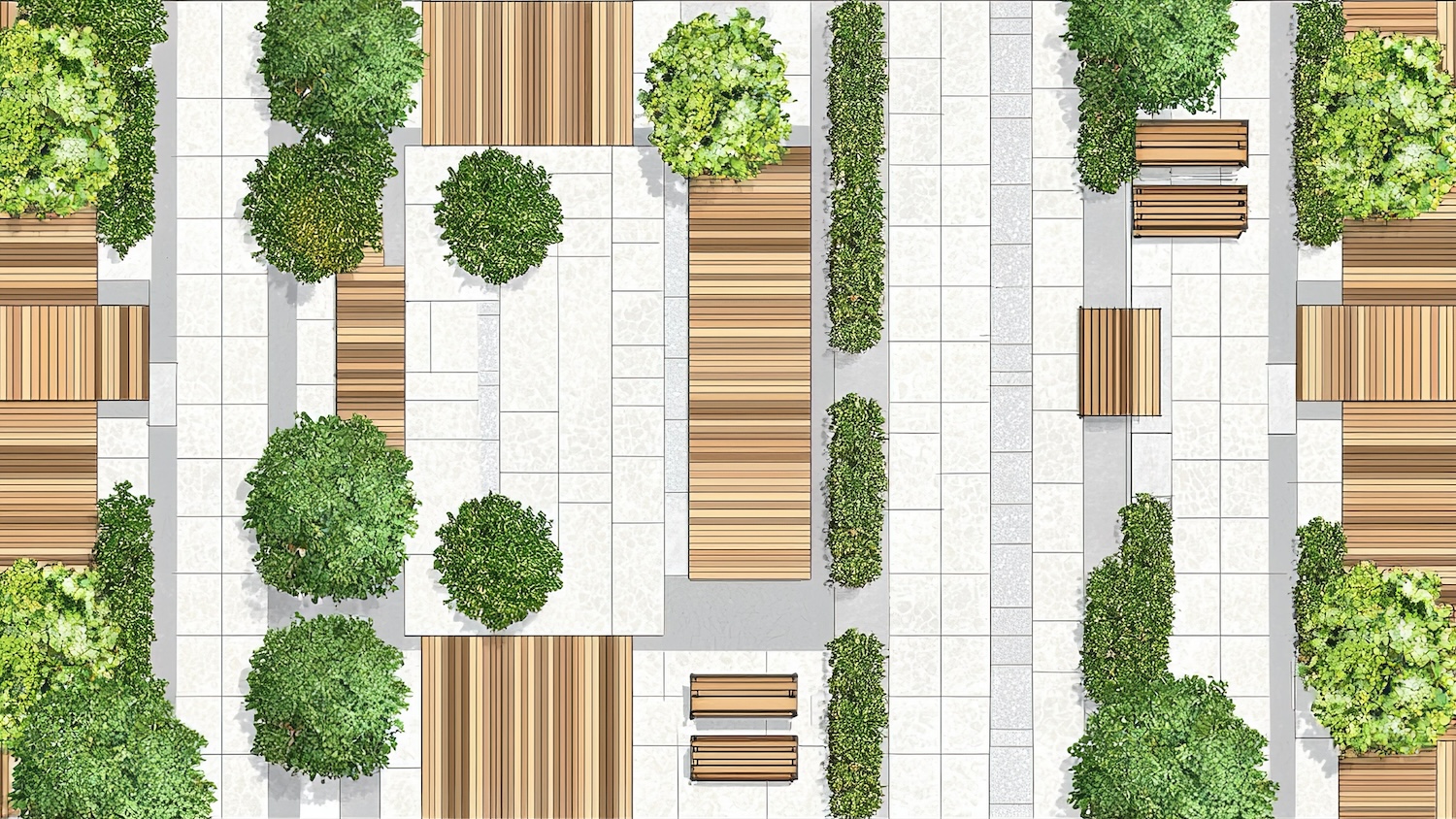
Landscape architecture doesn’t have a reputation for grasping technology with arms wide open, but US landscape designer and planning academic Dr Phil Fernberg is now leading the charge.
Dr Phil Fernberg occupies a rare space where environmental planning, landscape design and technology meet. The assistant research professor at Utah State University has made a name researching the role of AI in shaping the landscape architecture profession – the thesis for his PhD, awarded in 2024.
He moved into his new academic post in February, having spent 18 months at the US landscape architecture firm OJB Landscape Architecture, where he worked on technology strategy and digital transformation, including introducing AI tools.
His rare blend of expertise is reflected by the fact that he sits across three different departments at the university. These are landscape architecture and environmental planning, the Institute for Land, Water, and Air, and the Center for Anticipatory Intelligence, which specialises in multidisciplinary analytical techniques, bringing together students from across different colleges to solve, wicked problems such as biosecurity or supply chains.
He will be using his new base to research how AI can change a practice for the better, and what that might mean for the traditional role of the landscape designer.

“There is a marked difference between landscape-only firms and multidisciplinary practices. Most of our adoption of new technology is usually driven by allied disciplines needing to coordinate better.”
Dr Fernberg acknowledges that landscape design has been a little slower than architecture and construction to embrace digital tools for a number of reasons, not least because it’s a smaller industry and very few tools have been explicitly designed for landscape architecture.
BIMplus: What is the direction of travel for digitalisation in landscape architecture?
Dr Phil Fernberg: More people now know 3D and BIM programmes like Rhino, Revit or Vectorworks, and tools and plugins have been developed for landscape. Another factor is that many multidisciplinary firms have landscape departments.
We recently did a survey of AI among North American firms, and there was a marked difference between landscape-only firms and multidisciplinary practices. Most of our adoption of new technology is usually driven by allied disciplines needing to coordinate better. I think very soon there will be parity of technology use.
The survey was distributed to the American Society of Landscape Architects, the Canadian Society of Landscape Architects and the Landscape Architecture Foundation to find out what was happening in practice with AI, and we are about to publish the results.
I think that, for landscape architecture and probably construction as well, spatial computing is really going to be a gamechanger in the way that we are involved in design.
For example, XR and AR technologies are rapidly advancing, but for some, they seem to be taking a little bit of a back seat to all the AI advancement. however, I think that those technologies are going to be transformative to AEC practitioners, because everything we do has to do with a place and with feeling embodied in that place.
Over the next few years, it will become more common to design in a 3D space for landscape. So, if you can take spatial computing glasses or goggles on site, you can bring in your modelling or your BIM or your geospatial or whatever it is, and be projecting it onto the space, rather than trying to do it from afar.”
What impact do you think AI will have?
I stand strongly by the idea that the AI has the potential to transform the practice of landscape architecture and it will change the trajectory of the profession.
Right now, the zeitgeist is generative AI, and it’s all about image creation and text creation and video creation, which is already having an impact in terms of visualisation. Google Veo is creating seconds-long animations of spaces that don’t exist yet, but they look realistic. These used to be the kind of landscape animations that you would have to spend three days of billable hours creating. You can do that now in a fraction of the time. And that’s going to completely flip the script for aspects of the landscape designers work in: for example, pre-design and marketing.
A multidiscipline career
Dr Fernberg is a landscape designer and environmental planner whose appetite for working in the built environment was whetted from visiting cities around the world while working in entertainment on cruise ships.
A first degree in Latin American studies and urban planning was followed by a Master’s in landscape architecture at Louisiana State University. It was here that he became interested in using the latest geospatial technology to tackle ecological problems in the Mekong Delta, where he was providing indirect consultancy to the World Bank.
Stints as a landscape designer in multidisciplinary and engineering practices were followed by a PhD at Utah State University – an unusual career move in landscape design. A fellowship with the Landscape Architecture Foundation developed his interest in AI and his doctorate focused on the implications for AI on landscape architecture and design in the built environment.
He says: “My PhD supervisor is a computational forestry, computer science, and planning expert. I wanted to make sure that my training was not wholly focused within the discipline, but rather, where the boundaries of the discipline meet others.”
But I think it will be machine learning and predictive analytical tools that will have the biggest impact. You can already scan the entirety of thousands of acres of a place and understand very quickly anything, from where building footprints are to how water will behave on a site, and if you restore a certain ecosystem within that site, how that might evolve over time. [These are] the sort of predictive scenarios that we can now do to a level of a granularity that would never have been possible before.
A good example of this is the partnership between the Nature Conservancy in New South Wales in Australia and the Nari-Nari tribe to protect their 120 sq mile spiritual homeland. They have restored the former wetlands which had been grazed over and reverted to managing the land through traditional means. The Conservancy uses drones and machine learning algorithms, satellite data and computer vision to understand where water is and where it flows to and how it behaves. You wouldn’t be able to do that with many thousands of hectares by site walking alone.
Digital twins are another good example: people are starting to create digital twins of the landscape to be able to model different scenarios of how a landscape will change over time, through rapidly changing weather systems like drought, heat waves, or flooding.
Do landscape designers see AI more of a threat than an opportunity?
Our survey revealed equal parts concern and opportunity. It revealed that about half of landscape architects are using AI in some way. Most who say they are not currently using it intend to do so in the next few years.
The vast majority are concerned with ethics and IP. The next biggest concern is whether AI will diminish the design because there is not the thought being put into it, or that the models are inaccurate. They are also wondering whether technology might be a threat to their job.
What I take away from the survey and the research I’ve been doing is that concerns are not about the technology itself taking a job away, or automation taking jobs, but more deeply about what the value proposition of landscape design is today. It is already such a small discipline, and there is already concern whether enough people are coming into it to replace the retiring workforce.
What are the limitations of AI?
There are many limitations in capability, but the issue in landscape right now is a lack of good data for most of the kinds of activities AI might be used for. The data sets are either non-existent or do not have a good enough resolution. For example, sophisticated environmental modeling for a site design entails getting the data through surveys, and then processing it, which is time-consuming and often people don’t have the expertise to do it. So, we tend to use very rough data sets.
One of the things I am involved with at the Built Environment Futures Council is whether firms and institutions should be trying to create regional data lakes so that people can get universally accessible and accurate data for specific areas such as certain sites or buildings, or things like that.
“People are starting to create digital twins of the landscape to be able to model different scenarios of how a landscape will change over time, through rapidly changing weather systems.”
Tell us more about the Built Environment Futures Council
It’s an organisation focused on the US currently that is bringing design and construction leaders together to help shape the future of professionals in the built environment. It’s an interdisciplinary group, so there are architects, engineers, robotics experts, landscapers and construction professionals.
We’ve been involved in about 10 workshops over the past 12 months where we are looking at a variety of problem sets.
Most of it is centered around AI, and what we want AI to be. How does it change the way we might collaborate? What’s the value of what we do? How has automation changed the industry? What does human/machine partnering mean? Are any of the risks about AI outweighing the potential benefits? We are throwing lots of big questions out there and debating them.
What do you intend to research in your new role?
My own research focus will be on investigating emerging technology and how that will change landscape design practice. I’m keen to understand how working life might change and can be improved to better harness technology and create efficiencies. But I’ll also be challenging the simple everyday things – delving into the relationship with what knowledge workers call productivity tools like email, project management software, coordination tools, administrative overhead and digital overload.
Don’t miss out on BIM, information management and digital construction news: sign up to receive the BIMplus newsletter.












